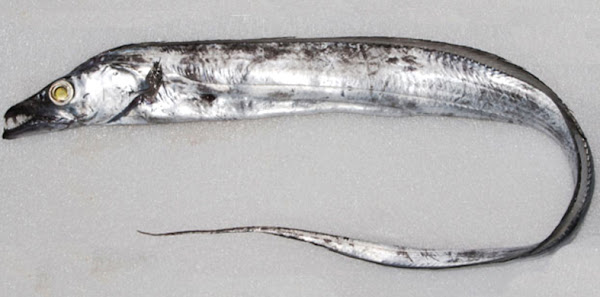The Largehead hairtail fish is a member of the cutlassfish family, Trichiuridae.
It is also known by many other different names such as Atlantic cutlassfish, Japanese cutlassfish, Pacific cutlassfish, Australian cutlassfish, Common Hairtail, cutlassfish, Grey Ribbon fish, Hairtail, Largehead Ribbonfish, Ribbon fish and Silver fish.
It is found throughout the tropical and temperate oceans of the world.
The Largehead hairtail fish is often considered as a single highly widespread species.
But it has been argued that it is a species complex that includes several species with the main groups being in the Atlantic, East Pacific, Indo-Pacific and Northwest Pacific.
Binomial name of this fish is Trichiurus lepturus. However, read some more information about this fish species below.
Largehead Hairtail Fish Characteristics
The Largehead hairtail fish has an extremely elongate and strongly compressed body (ribbon like).
They are generally steel blue in coloration with silvery reflection, pectoral fins are semi-transparent. Other fins are sometimes tinged with pale yellow.
Their color become uniform silvery grey sometime after death. Their mouth is very large with dermal process at the tip of each jaw.
The dorsal fin is relatively high, and anal fin reduced to minute spinules usually embedded in the skin or slightly breaking through.
Average body length of the Largehead hairtail fish is around 1m, but they can grow up to 2.34 m. Largest recorded live body weight of this fish is 5 kg. Photo and info from Wikipedia.

Diet
The Largehead hairtail fish are mainly feed on other fishes. And their other foods include shrimp and squid.
Breeding
The Largehead hairtail fish spawn throughout the year in tropical regions, but generally in the spring and summer in colder regions.
Their spawning depends on temperature as the larvae prefer water warmer than 21 °C, and are entirely absent at less than 16 °C. Their eggs are pelagic, and they become mature at about 2 years.
Uses
The Largehead hairtail fish are mainly used for food. They are eaten fried, grilled or by many other different ways.
Special Notes
The Largehead hairtail fish is a very important commercial fish species. Reported capture of more than 1.3 million tones in 2009, it was the 6th most important capture fish species.
By far the largest catches were reported by China and other countries reporting significant catches were South Korea, Japan and Pakistan.
The Largehead hairtail fish is generally found at 0 to 589 m depths. Average lifespan of these fish is around 15 years.
Today, this fish is mainly used for food. However, review full breed profile of this fish in the table below.
| Name | Largehead Hairtail |
| Kingdom | Animalia |
| Phylum | Chordata |
| Class | Actinopterygii |
| Order | Perciformes |
| Family | Trichiuridae |
| Genus | Trichiurus |
| Species | T. lepturus |
| Binomial Name | Trichiurus lepturus |
| Other Names | Atlantic cutlassfish, Japanese cutlassfish, Pacific cutlassfish, Australian cutlassfish, Common Hairtail, cutlassfish, Grey Ribbon fish, Hairtail, Largehead Ribbonfish, Ribbon fish and Silver fish, and also known by many other different names in different parts of the world |
| Breed Purpose | Mainly food |
| Special Notes | Economically very important fish species where it is found, used mainly for food, generally found at 0 to 589 m depths, around 15 years of average lifespan |
| Weight | Can reach around 5 kg |
| Breeding Method | Natural |
| Climate Tolerance | Almost all climates |
| Body Color | Gemerally steel blue with silvery reflection |
| Rarity | Common |
| Availability | Worldwide |






